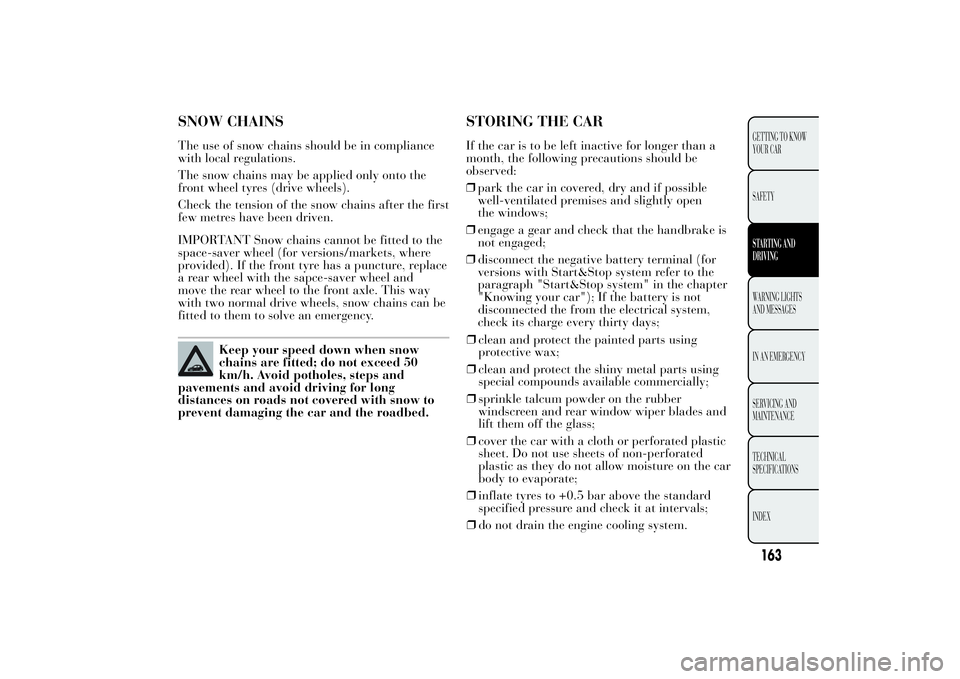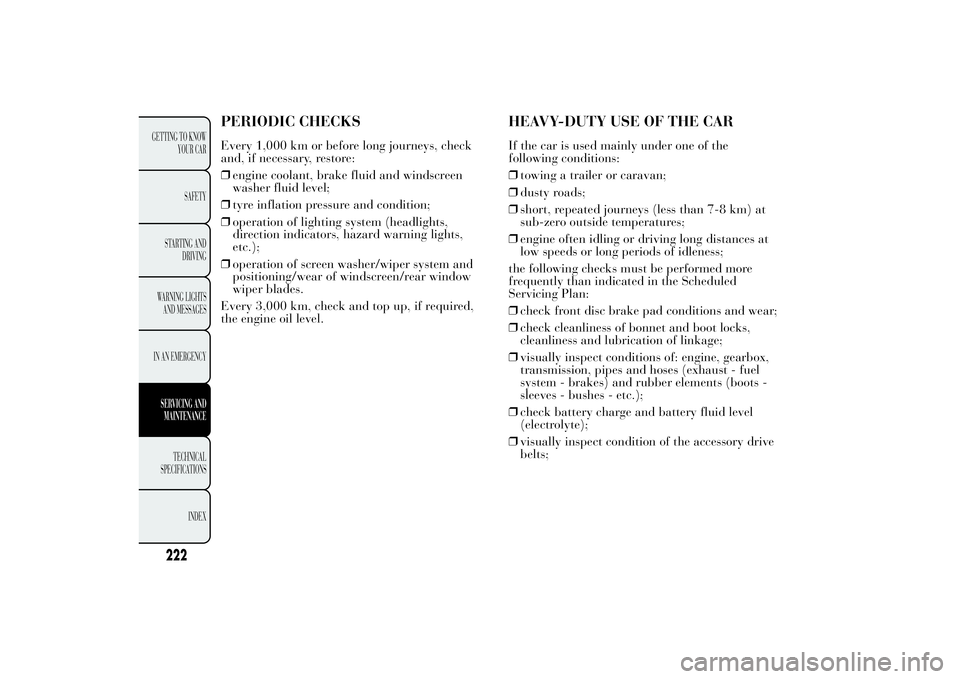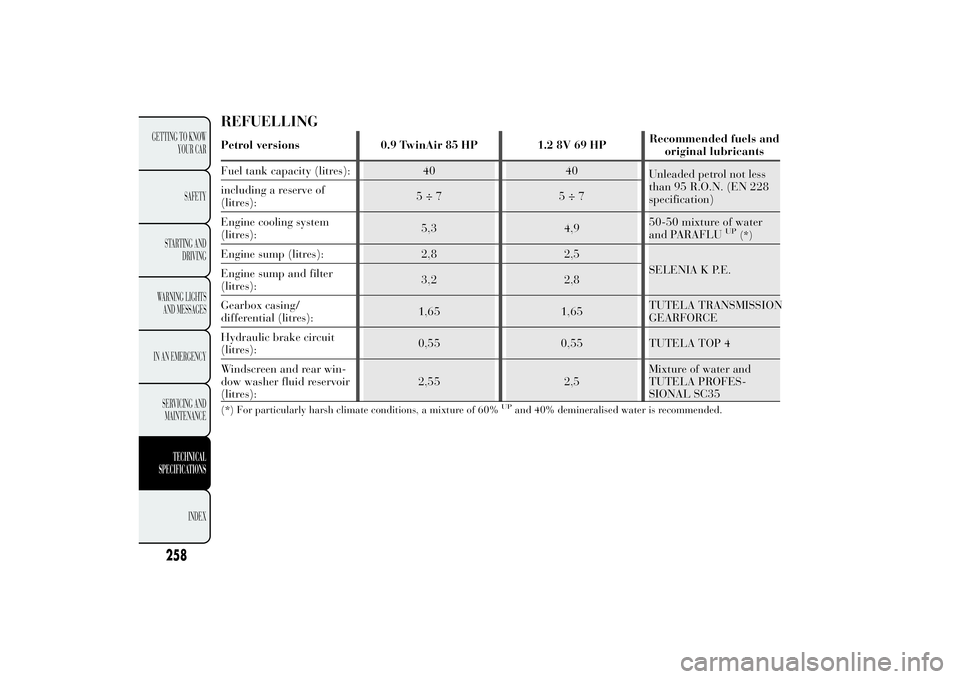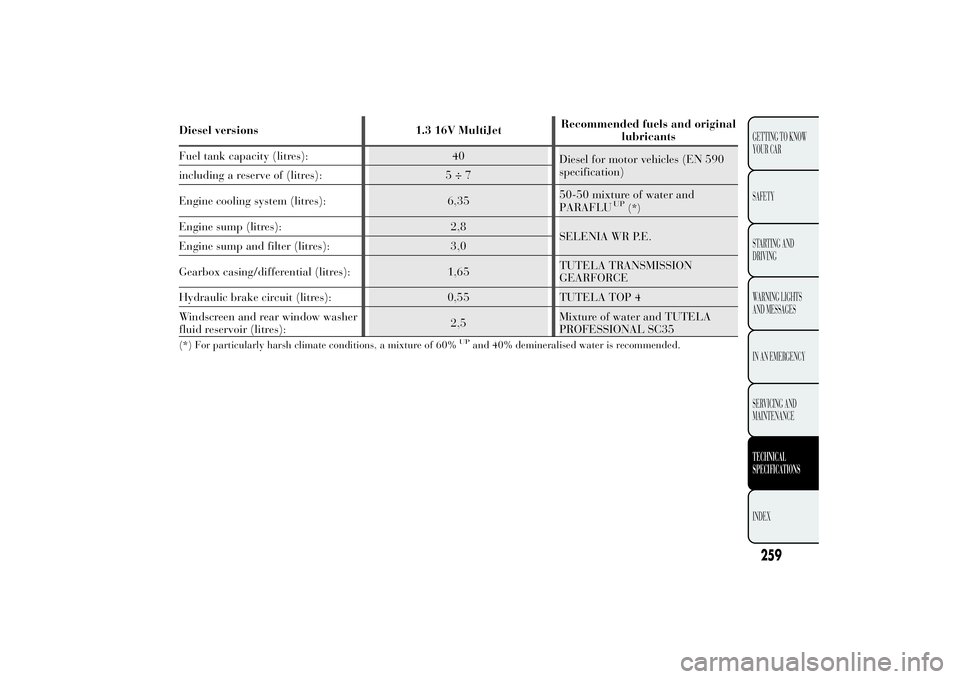Gear Lancia Ypsilon 2013 Owner handbook (in English)
[x] Cancel search | Manufacturer: LANCIA, Model Year: 2013, Model line: Ypsilon, Model: Lancia Ypsilon 2013Pages: 315, PDF Size: 13.18 MB
Page 167 of 315

STORING THE CARIf the car is to be left inactive for longer than a
month, the following precautions should be
observed:
❒park the car in covered, dry and if possible
well-ventilated premises and slightly open
the windows;
❒engage a gear and check that the handbrake is
not engaged;
❒disconnect the negative battery terminal (for
versions with Start&Stop system refer to the
paragraph "Start&Stop system" in the chapter
"Knowing your car"); If the battery is not
disconnected the from the electrical system,
check its charge every thirty days;
❒clean and protect the painted parts using
protective wax;
❒clean and protect the shiny metal parts using
special compounds available commercially;
❒sprinkle talcum powder on the rubber
windscreen and rear window wiper blades and
lift them off the glass;
❒cover the car with a cloth or perforated plastic
sheet. Do not use sheets of non-perforated
plastic as they do not allow moisture on the car
body to evaporate;
❒inflate tyres to +0.5 bar above the standard
specified pressure and check it at intervals;
❒do not drain the engine cooling system.
163GETTING TO KNOW
YOUR CAR
SAFETYSTARTING AND
DRIVINGWARNING LIGHTS
AND MESSAGES
IN AN EMERGENCY
SERVICING AND
MAINTENANCE
TECHNICAL
SPECIFICATIONS
INDEX
SNOW CHAINSThe use of snow chains should be in compliance
with local regulations.
The snow chains may be applied only onto the
front wheel tyres (drive wheels).
Check the tension of the snow chains after the first
few metres have been driven.
IMPORTANT Snow chains cannot be fitted to the
space-saver wheel (for versions/markets, where
provided). If the front tyre has a puncture, replace
a rear wheel with the sapce-saver wheel and
move the rear wheel to the front axle. This way
with two normal drive wheels, snow chains can be
fitted to them to solve an emergency.
Keep your speed down when snow
chains are fitted; do not exceed 50
km/h. Avoid potholes, steps and
pavements and avoid driving for long
distances on roads not covered with snow to
prevent damaging the car and the roadbed.
Page 182 of 315

IN AN EMERGENCY
In an emergency we recommend that you call the free-phone number found on the Warranty
Booklet. It is also possible to go to the www.lancia.com website to find the closest Lancia
Dealership.STARTING THE ENGINEGo to a Lancia Dealership immediately if
instrument panel warning light
remains on
constantly.
JUMP STARTING
If the battery is flat, the engine may be started
using an auxiliary battery with the same capacity
or a little higher than the flat one.To start the vehicle, proceed as follows:
❒connect the positive terminals (sign + near the
terminal) of the two batteries with a jump lead
fig. 114;
❒with a second lead, connect the negative
terminal – of the auxiliary battery to an
earthing point
on the engine or the gearbox of
the car to be started;
❒start the engine;
❒when the engine has been started, remove the
leads reversing the order above.
For versions with Start&Stop system, in case of
starting by auxiliary battery, refer to the
paragraph “Start&Stop system” in the chapter
“Getting to know your car”.
If after a few attempts the engine does not start,
do not persist but contact a Lancia Dealership.
IMPORTANT Do not directly connect the negative
terminals of the two batteries: sparks could ignite
explosive gas released from the battery. If the
auxiliary battery is installed on another car,
prevent accidental contact between metallic parts
of the two cars.
fig. 114
L0F0084
178
GETTING TO KNOW
YOUR CAR
SAFETY
STARTING AND
DRIVING
WARNING LIGHTS
AND MESSAGESIN AN EMERGENCYSERVICING AND
MAINTENANCE
TECHNICAL
SPECIFICATIONS
INDEX
Page 186 of 315

To change a wheel proceed as follows:
❒Stop the car in a position that is not dangerous
for oncoming traffic where you can change the
wheel safely. The ground must be flat and
sufficiently compact;
❒switch off the engine, pull up the handbrake
and engage the 1
stgear or the reverse gear.
Wear the reflective safety jacket (compulsory by
law in certain countries) before getting out of
the car;
❒open the luggage compartment, pull tab A
fig. 115 and lift up the mat;❒using the wrench A fig. 116 located in the tool
box, loosen the locking device, take the tool
box B and place it close to the wheel to be
replaced. Then take the space-saver wheel C;
fig. 115
L0F0099
fig. 116
L0F0183
182
GETTING TO KNOW
YOUR CAR
SAFETY
STARTING AND
DRIVING
WARNING LIGHTS
AND MESSAGESIN AN EMERGENCYSERVICING AND
MAINTENANCE
TECHNICAL
SPECIFICATIONS
INDEX
Page 223 of 315

Thousands of miles 18 36 54 72 90 108
Thousands of km 30 60 90 120 150 180
Months 24 48 72 96 120 144
Check timing toothed belt conditions (excluding 0.9 TwinAir 85 HP engine)●●
Check tappet clearance and adjust as necessary (1.2 8V 69 HP version)●●●
Check handbrake lever travel and adjust, if required●●●●●●
Check exhaust gas emissions/smokiness●●●●●●
Check operation of engine management systems (using diagnosis socket)●●●●●●
Check gearbox oil level●●
Check battery charge status and possibly recharge●●●●●●
Replace spark plugs●●●●●●
Replace accessory drive belt(s)●
Replacement of timing toothed belt (0.9 TwinAir 85 HP engine excluded)
(1)
●
Replace air cleaner cartridge●●●
Replace engine oil and oil filter (or every 24 months)
(2)
●●●●●●
Change brake fluid (or every 24 months)●●●
Change pollen filter (or every 12 months)●●●●●●
(1) Regardless of the distance covered, the timing belt must be changed every four years for particularly demanding use (cold
climates, town driving, long periods of idling) or at least every five years.
(2) If the car's annual mileage is less than 10,000 km, the engine oil and filter must be replaced every 12 months.
219GETTING TO KNOW
YOUR CAR
SAFETY
STARTING AND
DRIVING
WARNING LIGHTS
AND MESSAGES
IN AN EMERGENCYSERVICING AND
MAINTENANCETECHNICAL
SPECIFICATIONS
INDEX
Page 225 of 315

Thousands of miles 21 42 63 84 105
Thousands of km 35 70 105 140 175
Months 24 48 72 96 120
Check operation of engine management systems (using diagnosis socket)●●●●●
Check gearbox oil level●●●●●
Check battery charge status and possibly recharge●●●●●
Replace fuel filter cartridge●●
Replace accessory drive belt(s)●
Replace air cleaner cartridge●●●●●
Replace engine oil and oil filter (or every 24 months)
(1) (2)
Change brake fluid (or every 24 months)●●
Change pollen filter (or every 12 months)●●●●●(1) If the car is used mainly for town driving, the engine oil and filter should be changed every 12 months.
221GETTING TO KNOW
YOUR CAR
SAFETY
STARTING AND
DRIVING
WARNING LIGHTS
AND MESSAGES
IN AN EMERGENCYSERVICING AND
MAINTENANCETECHNICAL
SPECIFICATIONS
INDEX
( ) The actual interval for changing the oil and replacing the engine oil filter depends on the car usage conditions and is
signalled by the warning light or message (if present) in the instrument panel and must never exceed 24 months. 2
Page 226 of 315

PERIODIC CHECKSEvery 1,000 km or before long journeys, check
and, if necessary, restore:
❒engine coolant, brake fluid and windscreen
washer fluid level;
❒tyre inflation pressure and condition;
❒operation of lighting system (headlights,
direction indicators, hazard warning lights,
etc.);
❒operation of screen washer/wiper system and
positioning/wear of windscreen/rear window
wiper blades.
Every 3,000 km, check and top up, if required,
the engine oil level.
HEAVY-DUTY USE OF THE CARIf the car is used mainly under one of the
following conditions:
❒towing a trailer or caravan;
❒dusty roads;
❒short, repeated journeys (less than 7-8 km) at
sub-zero outside temperatures;
❒engine often idling or driving long distances at
low speeds or long periods of idleness;
the following checks must be performed more
frequently than indicated in the Scheduled
Servicing Plan:
❒check front disc brake pad conditions and wear;
❒check cleanliness of bonnet and boot locks,
cleanliness and lubrication of linkage;
❒visually inspect conditions of: engine, gearbox,
transmission, pipes and hoses (exhaust - fuel
system - brakes) and rubber elements (boots -
sleeves - bushes - etc.);
❒check battery charge and battery fluid level
(electrolyte);
❒visually inspect condition of the accessory drive
belts;
222
GETTING TO KNOW
YOUR CAR
SAFETY
STARTING AND
DRIVING
WARNING LIGHTS
AND MESSAGES
IN AN EMERGENCYSERVICING AND
MAINTENANCE
TECHNICAL
SPECIFICATIONS
INDEX
Page 247 of 315

ENGINE CODE - BODYWORK VERSIONS(*)Versions with long gear ratios
(**)Versions with short gear ratios and Start&Stop
243GETTING TO KNOW
YOUR CAR
SAFETY
STARTING AND
DRIVING
WARNING LIGHTS
AND MESSAGES
IN AN EMERGENCY
SERVICING AND
MAINTENANCETECHNICAL
SPECIFICATIONSINDEX
(* *)Versions with short gear ratios Start&Stop* without Versions Engine code Body versions
0.9 TwinAir 85 HP312A2000312YXG1A Y1 (4-seater)
312YXG1A Y1B (5-seater)
1.2 8V 69 HP
(*)
169A4000312YXA1A Y0 (4-seater)
312YXA1A Y0B (5-seater)
1.2 8V 69 HP
(**)
169A4000312YXA1A Y0D (4-seater)
312YXA1A Y0E (5-seater)
1.28V6
(***)
169A4000312YXA1A Y0F ( )
312YXA1A Y0G (5-seater)
1.3 16v MultiJet199B1000312YXE1A Y2 (4-seater)
312YXE1A Y2B (5-seater)
4-seater
9HP
Page 249 of 315

FUEL SUPPLYVersions Power supply
0.9 TwinAir 85 HPTimed sequential Multipoint electronic injection, with knock control and intake
valve variable actuation
1.2 8V 69 HPMultipoint sequential timed electronic injection, returnless system
1.3 16V MultiJetElectronically controlled Common Rail MultiJet direct injection with turbocharger
and intercooler
WARNING
Modifications or repairs to the fuel supply system that are not carried out correctly or
do not take the system's technical specifications into account can cause malfunctions
leading to the risk of fire.
TRANSMISSIONVersions Gearbox Clutch Drive
0.9 TwinAir 85 HP
Five forward gears and
reverse with synchromesh for
forward gear engagementSelf-adjusting pedal without
idle strokeFront 1.2 8V 69 HP
1.3 16v MultiJet
245GETTING TO KNOW
YOUR CAR
SAFETY
STARTING AND
DRIVING
WARNING LIGHTS
AND MESSAGES
IN AN EMERGENCY
SERVICING AND
MAINTENANCETECHNICAL
SPECIFICATIONSINDEX
Page 262 of 315

REFUELLINGPetrol versions 0.9 TwinAir 85 HP 1.2 8V 69 HPRecommended fuels and
original lubricants
Fuel tank capacity (litres): 40 40
Unleaded petrol not less
than 95 R.O.N. (EN 228
specification) including a reserve of
(litres):5÷7 5÷7
Engine cooling system
(litres):5,3 4,950-50 mixture of water
and PARAFLU
UP
(*)
Engine sump (litres): 2,8 2,5
SELENIA K P.E.
Engine sump and filter
(litres):3,2 2,8
Gearbox casing/
differential (litres):1,65 1,65TUTELA TRANSMIS
GEARFORCE
Hydraulic brake circuit
(litres):0,55 0,55 TUTELA TOP 4
Windscreen and rear win-
dow washer fluid reservoir
(litres):2,55 2,5Mixture of water and
TUTELA PROFES-
SIONAL SC35(*) For particularly harsh climate conditions, a mixture of 60%
UP
and 40% demineralised water is recommended.
258
GETTING TO KNOW
YOUR CAR
SAFETY
STARTING AND
DRIVING
WARNING LIGHTS
AND MESSAGES
IN AN EMERGENCY
SERVICING AND
MAINTENANCE
TECHNICAL
SPECIFICATIONS
INDEX
SION
Page 263 of 315

Diesel versions 1.3 16V MultiJetRecommended fuels and original
lubricants
Fuel tank capacity (litres): 40
Diesel for motor vehicles (EN 590
specification)
including a reserve of (litres): 5 ÷ 7
Engine cooling system (litres): 6,3550-50 mixture of water and
UP
(*)
Engine sump (litres): 2,8
SELENIA WR P.E.
Engine sump and filter (litres): 3,0
Gearbox casing/differential (litres): 1,65TUTELA TRANSMISSION
Hydraulic brake circuit (litres): 0,55 TUTELA TOP 4
Windscreen and rear window washer
fluid reservoir (litres):2,5Mixture of water and TUTELA
PROFESSIONAL SC35(*) For particularly harsh climate conditions, a mixture of 60%
UP
and 40% demineralised water is recommended.
259GETTING TO KNOW
YOUR CAR
SAFETY
STARTING AND
DRIVING
WARNING LIGHTS
AND MESSAGES
IN AN EMERGENCY
SERVICING AND
MAINTENANCETECHNICAL
SPECIFICATIONSINDEX
GEARFORCE PARAFLU